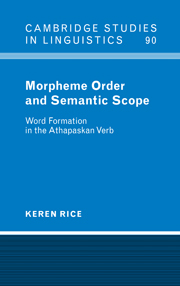Summary
Whenever linguists discover that I work on Athapaskan languages, I can anticipate the first question that they will ask – however could a child come to learn the order of morphemes in the verb of one of these languages? The order of morphemes seems to be completely without rhyme or reason. Morpheme order is thus a question that is everpresent in one's mind when studying languages of this family. I first began to tackle this problem in 1991, with work on the so-called disjunct prefixes of the Athapaskan verb. A crosslinguistic survey revealed something very striking – little variation existed across the family in terms of the ordering of these elements. I began to feel that I was on the road to an explanation of the ordering of this part of the verb, but the so-called conjunct portion of the verb still left me baffled. One day in the early 1990s Chomsky gave a talk here at the University of Toronto, and I began to get some glimmerings; at least the ordering began to look somewhat less random than it had hitherto seemed. It was after this that I decided that this was a research question that I had to pursue. The quest to come to some personal understanding of morpheme order took me several years, as there was much I had to learn in many different arenas.
- Type
- Chapter
- Information
- Morpheme Order and Semantic ScopeWord Formation in the Athapaskan Verb, pp. xi - xivPublisher: Cambridge University PressPrint publication year: 2000



